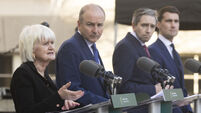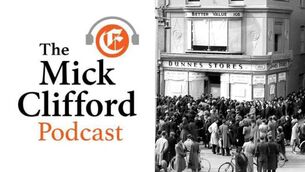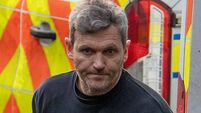Would the real pontiff please stand up ?

IS A section of the media in danger of creating a ‘fantasy’ Francis — a Pope whose perceived liberalism is not really rooted in reality?
As the Synod of the Family opens in Rome and speculation begins about a possible papal visit to Ireland in 2018, we are left to ponder the enigma that is Jorge Mario Bergoglio.
Hailed in the current edition of Vanity Fair as “the people’s pontiff”, there is no denying the popularity of Francis. The huge crowds that turned out to greet him during his recent visit to Cuba and the US were further testimony to this. It was at the end of this visit, at the closing mass in Philadelphia, that he announced that the next World Meeting of Families will be held in Dublin in 2018. Whether the pope himself will travel to Ireland for this event — held every three years — remains a matter of speculation.
This is a pope who has already made the cover of Time magazine and (more improbably) Rolling Stone magazine. And the accompanying articles, like the new one in Vanity Fair, have been laudatory. His latest biographer, Austen Ivereigh, has even called his book on Francis The Great Reformer, and sub-titled it ‘Francis and the making of a Radical Pope’. But is Jorge Mario Bergoglio really a radical?
This is a pope of seeming contradictions, and five years after his election we’re still trying to figure out what his real agenda consists of. He has clearly made a message of mercy, forgiveness, and solidarity (“a poor Church, for the poor”) a central plank of that agenda. And he has surprised us, not least through a series of potent gestures.
We are again reminded in the Vanity Fair article — ‘How Pope Francis became the people’s pontiff’, by Paul Elie — of his decision to opt for a modest suite in Casa Santa Marta, a Vatican guesthouse, rather than the opulence of the papal apartments, his abandonment of the traditional red slippers (sticking to a shabby pair of plain black shoes), and for driving a Ford Focus.

He happily poses for selfies (to the disquiet of his security detail), telephones journalists, nuns, and unmarried mothers, kisses babies, and dispenses regularly with protocol, formality and convention — all of which is refreshing and has helped to endear him to vast numbers of people, both within and outside of the Church. It is a welcome move away from a monarchical papacy.
In addition to the change of style, there have of course been some reforms. Perhaps the most significant has been described in Vanity Fair.
“Shortly after his election, he named a group of eight cardinal advisers from around the world, reversing centuries of precedent that the Pope, as Christ’s vicar on earth, acts alone — and creating a model for a more collegial approach to Church governance.”
In fact, that model already exists in the form of the Synod of Bishops. It opened again in Rome yesterday in order to conclude the two-part process which began last October.
Its task is to examine the role of the family in the Church and society. It only has advisory powers, however, and in the end whatever document will emerge will be the pope’s. But he could, if he wished, make the Synod part of a real exercise in collegiality. And he could also make it a more inclusive assembly.
It has not gone unnoticed that, for the next fortnight, 300 celibate males will discuss the future of the family — in the absence of women. The remark of Cardinal Suenens of Belgium at the opening of the Second Vatican Council in 1962 comes to mind: “Where is the other half of humankind?”

Francis has also brought in the tough-talking Cardinal George Pell, former archbishop of Sydney, to be his financial commissar and to sort out the scandal-ridden Vatican Bank.
The intrigues and scandals associated with this corrupt institution were contributory factors in Benedict XVI’s resignation. In the meantime, the pope has simplified the Church’s archaic and costly annulment process and has said he will permit priests to absolve women of the sin of abortion. Beyond that, he shows no awareness of the extreme detachment of Catholic sexual teaching from Catholic sexual practice.
His much acclaimed encyclical ‘Laudato Si’ (‘Praise be’), published in May, on climate change, the environment, and the future of the planet, made only a passing reference to the population explosion.
As archbishop of Buenos Aires, Jorge Mario Bergoglio opposed plans by the government in Argentina to introduce family planning programmes involving the use of contraceptives. This continues to be Vatican policy globally, a policy whose effects on families in some of the poorest and more deprived regions of the world may be very harsh indeed.
Francis has declared it part of his mission to restore credibility and authenticity to a Church deeply scarred and bedevilled by clerical sex abuse and cover-ups. Some of the worst examples of the latter have occurred in the US, where if justice was properly done, several American bishops would now be behind bars for their complicity and criminal negligence.

Yet, during his recent visit, Francis praised US bishops for their “courage” in handling sex abuse cases — a decision described by one of the pope’s biographers, Paul Vallely, as “a bizarre response”.
Little wonder that there was an angry reaction from abuse victims who said the Church has not done enough. David Clohessy, head of the Survivors Network of Those Abused by Priests, who himself was abused by a priest, said he unimpressed by Francis’s words.
“It’s dreadfully disappointing,” said Mr Clohessy. “Bishops have been cowardly, not courageous, and still are. What grudging, belated steps they have taken have been forced on them by the most courageous people in this crisis, abuse victims and their families.”
Mr Clohessy said Francis “refuses to even be honest about what this crisis is”. This was in light of the fact that the pope did not use the words “sexual abuse” in his remarks to the bishops, referring instead to the scandals as “difficult moments”. Mr Clohessy is right — the Church has not done enough, neither in the States and other parts of the world, including here.
“Doing something to raise the profile and status of women is one of the touchstones by which the papacy of Jorge Mario Bergoglio will be judged,” said Paul Vallely, the sub-title of whose biography, Untying the Knots, appropriately hints at the paradoxes of the first Jesuit and first Argentinian Pope in history. What is clear five years into this papacy is that quite a few of the knots have not yet been untied.

His attitude to women is one of the most enigmatic features of his papacy. Early on, Francis declared there was a need for a “new theology of women”, but not much more has been heard of this. Does Francis have any notion of what this “new theology” might be?
In his apostolic exhortation ‘Evangelii Gaudium’ (‘The Joy of the Gospel’), issued in November 2013, Francis wrote of the “need to create still broader opportunities for a more incisive female presence in the Church, but eight sentences later said: “The reservation of the priesthood to males... is not a question open to discussion.”
It is not a question open to discussion only because Francis’s predecessor, John Paul II, said it was not — the present pope could reopen it if he so wished. Clearly, Francis does not.
In her book, The Elephant in the Church, Mary T Malone (now back in her native Wexford after 40 years in Canada, where she taught at Toronto’s St Augustine Seminary and at the University of Waterloo) said: “Women are the topic on which Pope Francis has least to say, except to indicate that he is fearful of feminists, or ‘female machismo’ as he terms it.”
And she says that, when he speaks of a new theology of women, “he is definitely not speaking about Christian feminist theology, but about a theology of women done by men, as it has always been done... The Church is a hierarchical patriarchy, a graded society where women are placed on the very lowest rung.”
These sentiments were echoed at the end of the pope’s US visit by New York Times columnist Maureen Dowd: “Pope Francis would be the perfect pontiff — if he lived in the 19th century.”
But how can he continue to condone the idea that women should have no voice in Church decisions? In a scandal that cascaded for decades with abuses and cover-ups, the Church was revealed to be monstrously warped in its attitudes about sex and sense of right and wrong. Yet, shortly after he was elected, Francis rejected the idea that the institution could benefit from opening itself to the hearts and minds of women.
Vallely, author of Pope Francis: Struggle for the Soul of Catholicism, agrees that women are the Pontiff’s greatest area of weakness.
“He understands there is a problem with the role of women in the Church and talks frequently about the need for a ‘new profound theology of women’, but he has no idea how to implement this,” said Vallely. “In practice, he is a man of a certain age from a macho Latin American cultural background who has limited understanding of the women in the modern world, despite the fact he has had a number of close women friends.”

This pope will be 79 in December, and he told a journalist in 2015 that he had an intuition that his papacy will not be long. According to biographer Austen Ivereigh, he has not ruled out resignation “when he hopes to have achieved what is in his heart to complete”.
But what is really in the heart of Pope Francis remains a mystery. That’s yet another facet of this most enigmatic of Popes. But he has told friends he cannot resign until Benedict XVI dies.
Meanwhile, the observation by Peter Stanford, former editor of the Catholic Herald, is pertinent: “For all his charm and integrity, this is not a Catholic leader who is about to blur the fundamental boundaries between his Church and secular values.”
To believe otherwise is to believe in a fantasy Francis.















